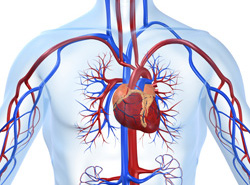Healthy Heart Toolkit and Research: Steps You Can Take
Steps You Can Take to Reduce Health Effects from Air Pollution
Studies show that air pollution can trigger heart attacks, strokes and worsen heart failure in people who are at risk for these conditions. If you have a heart condition, you could benefit by reducing your exposure to high levels of air pollution.

When are air pollution levels high?
- Any time of year
- When weather is calm
- Near busy roads
- In urban areas
- In industrial areas
- When there is smoke
Are you at risk?

Greater risk if you have or have had:
- Coronary artery disease
- Angina (chest pain)
- A heart attack
- Bypass surgery or an angioplasty
- Heart failure
- An internal cardiac defibrillator
- A stroke or transient ischemic attack
- Blockages in the arteries of the neck or legs
Steps to Protect Your Heart

When pollution is high, you can reduce the amount of particle pollution you inhale
- Know when and where particle pollution levels may be unhealthy. Particle pollution levels can be high at any time of the year. They can be higher near busy roads or industrial areas or during rush hour traffic. When there is smoke in the air from forest fires, burning vegetation or wood stoves, higher levels of particle pollution are present.
- Check the Air Quality Index, which provides forecasts of daily air quality. This index provides six color-coded categories that show different levels of health concern for air pollution levels by state or zip code.
- Plan activities when and where pollution levels are lower. When particle levels outdoors are unhealthy, delay activity or exercise until the air is cleaner or move the activity indoors.
- Change your activity level. When the air is polluted, reduce activity. Go for a walk rather than a jog, for example. Delay outdoor activity when the air is polluted or exercise indoors.
- Reduce overall risk of heart disease or stroke. Make healthy lifestyle changes as described above.
- Know the warning signs of heart attack or stroke. If you feel symptoms, even if they go away, stop any activity and seek medical help immediately.
How to Reduce your Risk?

Reduce your overall risk of heart disease and stroke
- Eat healthy foods
- Control blood pressure
- Control cholesterol levels
- Exercise more (first check with your health care provider)
- Stop smoking
- Take aspirin and heart medication as directed
- Talk to your health care provider about treatment
Warning Signs of a Heart Attack
- Chest discomfort (uncomfortable pressure, fullness, squeezing, or pain in the center of the chest that lasts more than a few minutes or goes
away and comes back) - Discomfort in other areas of the upper body (pain or discomfort in one or both arms, the back, neck, jaw, or stomach)
- Shortness of breath
- Other signs may include breaking out in cold sweats, nausea, or light-headedness
Warning Signs of a Stroke
- Sudden numbness or weakness in the face, arm or leg (especially on one side of the body)
- Confusion, trouble speaking or understanding
- Problems seeing
- Dizziness, loss of balance or coordination, or trouble walking
- Severe headache with no known cause
